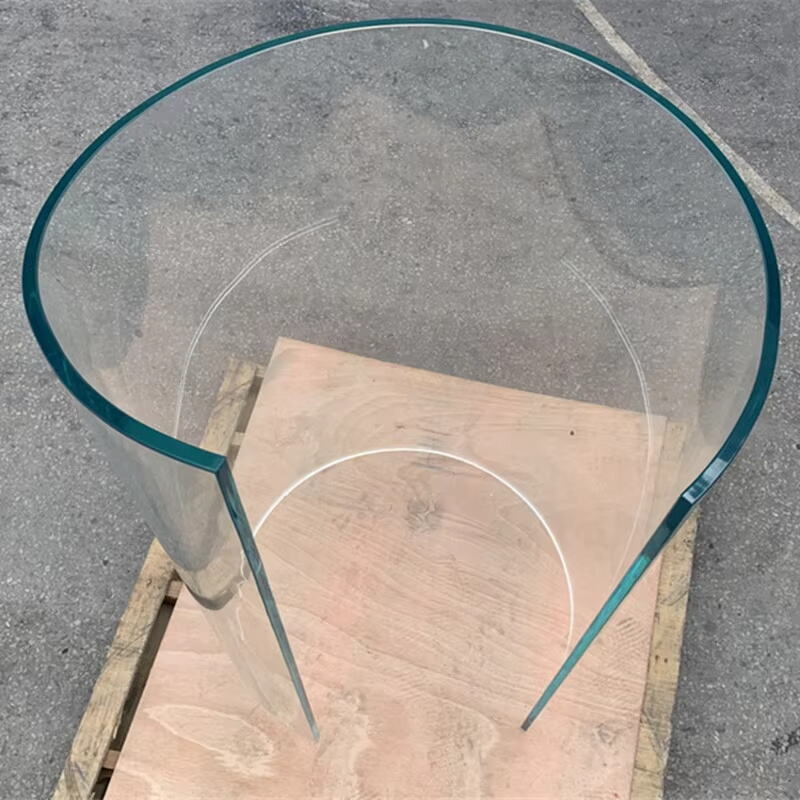Transforming Architectural Facades with Curved Glass
Aesthetic Versatility in Building Exteriors
Architects are now working with curved glass to create buildings that look completely different from anything we've seen before. Instead of those standard rectangular boxes, they can build flowing forms that seem almost alive. What really stands out is how this special glass plays with light throughout the day. Some buildings catch the morning sun one way and then change appearance entirely by afternoon. Take the Guggenheim in Bilbao as proof – though actually made mostly of titanium, not glass, it shows what happens when designers break free from straight lines. Glass manufacturers can tweak textures and levels of transparency too, which means architects get to experiment with materials in ways that match their creative vision without compromising on function or beauty.
For example, architects can craft forms that mimic natural elements, creating buildings that blend seamlessly into their environments. The versatility of curved glass panels means designers can experiment with different finishes and colors, enhancing both the aesthetic appeal and functional benefits of architectural facades.
Energy Efficiency and Solar Performance
Curved glass makes a big difference when it comes to how well buildings perform with solar energy. It works great at getting sunlight inside while cutting down on annoying glare, which helps save energy overall. When manufacturers add special coatings and tint to these glass panels, they actually do a pretty good job at keeping indoor temperatures stable, so less energy gets used for heating or air conditioning. Many modern buildings with curved glass walls have shown they can be really efficient with energy, sometimes even earning those coveted LEED certifications because of their clever designs. Getting the angles right when installing curved glass matters a lot for making sure solar performance hits its peak potential. That's why more and more architects who care about green building practices are turning to curved glass solutions these days.
Studies corroborate that these energy-efficient designs contribute to cost savings in energy consumption while promoting eco-friendly practices in construction. Ultimately, curved glass applications are smart choices that balance aesthetics with sustainability, catering to modern architectural priorities.
Enhancing Natural Light with Curved Glass Skylights
Innovative Designs for Atriums and Roofs
Curved glass skylights really change the game when it comes to atriums and roof areas, turning them into bright, colorful spaces full of natural light that makes people feel better inside. What's great about this type of glass is how flexible it is for design purposes. Architects can shape these skylights in all sorts of ways that actually match up pretty well with whatever look they want for the whole building. A lot of architecture companies have started using these kinds of skylights lately because they just stand out so much. And there's research showing that having more natural light around boosts productivity levels too. Adding automated shading systems to the mix works wonders for controlling energy usage and keeping temperatures stable throughout different seasons. This combination brings aesthetics and functionality right into the heart of modern architectural projects without compromising either aspect.
Maximizing Daylight in Commercial Spaces
When commercial buildings use curved glass designs, they let in way more natural light which cuts down on how much artificial lighting is needed inside. Studies show time and again that people working in well lit spaces tend to be more productive and generally happier at their jobs. Architects now often turn to special software for daylight analysis during the design phase. This helps them see how light will move through different versions of the building before construction even starts. Real world examples back this up too many companies with these glass features report saving money on electricity bills over time. The effect goes beyond just looking nice though. Spaces feel better overall when there's plenty of sunlight coming in, plus businesses actually save cash while being kinder to the environment in the long run.
Curved Glass in Modern Interior Design
Dynamic Partition Walls and Dividers
Curved glass partitions have really taken off in contemporary interior design lately. They bring together style and open space in ways that just transform how rooms feel. The beauty of these curved walls is they let light flow through and create those nice visual connections between areas, yet still keep private spaces private. That's why so many offices and homes now feature them, especially when the goal is to encourage people to interact more freely. Interior designers love working with this material because it plays well with other elements. Wood accents next to curved glass add warmth, while metals create striking contrasts. Plus, advances in glass manufacturing mean these partitions aren't just pretty but actually hold up well structurally too. And bonus? They do a decent job blocking noise, which makes all the difference in busy environments.
Sculptural Staircases and Balustrades
Curved glass stairs are becoming quite the statement piece in modern architecture, mixing artistry with actual usefulness. These glass staircase installations really grab attention when placed in a room, acting almost like sculptures themselves. The clear glass railings let people see through them which makes walking around safer but doesn't block the view outside or across the space. Many designers are adding LED lights along the edges now too. At night, these lit up staircases create some seriously impressive visuals that transform how a whole area feels. Manufacturers have made significant improvements recently that allow builders to create all sorts of custom designs while still keeping everything structurally sound and compliant with building codes.
For more detailed insights verify the product descriptions and images in the Curved Glass.

Structural Innovations Using Curved Glass
Load-Bearing Glass Walls and Canopies
Curved glass walls that actually hold up buildings are changing how architects think about space and light. Instead of traditional walls, these modern structures let in way more natural light while still standing strong. They work great for both office spaces and homes where people want that open feel without sacrificing support. The engineering behind them is pretty impressive too since they can handle serious weight loads despite looking so delicate. We've seen this technology put to good use in several skyscrapers around the world, which shows just how durable and adaptable these glass walls really are. What makes them special is their ability to bend and shape into things like canopy covers over entrances or walkways. These curved glass structures protect against rain and sun but still give clear views through them. Architects love working with this material because it lets them create designs that look amazing while getting the job done practically.
Transparent Column Systems
Architects are starting to see curved glass not just as decoration but as serious building material, especially when used in those see-through column systems. The result? Buildings that look amazing while still holding everything up. Glass columns today aren't just pretty faces anymore. They actually stand up to real world stress tests better than many people expect. Manufacturers have gotten really good at shaping and joining glass pieces so these columns work in actual construction projects. What makes them special though is how they let sunlight bounce around inside buildings. Spaces feel brighter and more open because the light spreads out instead of hitting walls dead on. For anyone designing commercial spaces or luxury homes, incorporating curved glass columns means getting the best of both worlds transparency and strength. Plus, who doesn't want their building to stand out from the usual concrete and steel look?
Sustainability and Curved Glass Applications
Thermal Insulation and Recycled Materials
Curved glass designs now come with some pretty impressive thermal insulation tech built right in, making buildings much more energy efficient overall. The big plus here is that we need less artificial heating and cooling systems inside these structures, so it definitely helps move us toward more sustainable architecture. Take the manufacturing side of things for example. When companies start using recycled materials to make this curved glass, they're doing their part for the environment too. According to research published by ArchDaily, buildings with high performance curved glass actually cut down on those costly heating and cooling bills quite a bit. That shows just how effective this material really is when it comes to saving energy. As more people push for greener buildings across the board, manufacturers are finding ways to produce curved glass sustainably as well, which makes sense if we want our cities to be both beautiful and environmentally responsible going forward.
Green Building Certifications
Curved glass has become a game changer in architectural design, offering both visual flair and helping buildings earn those coveted green certifications like LEED and BREEAM. When architects incorporate this type of glass into their designs, they're able to cut down on carbon emissions significantly while making spaces inside much more comfortable for occupants. More and more designers are jumping on board with curved glass for sustainability reasons. Take a look at some recent projects featured on ArchDaily, where several buildings achieved top green ratings thanks to creative uses of curved glass elements throughout their structures. These certifications matter a lot in today's construction world because they push architects to think about how their work affects the environment without sacrificing beauty or structural integrity.
Technological Advancements in Curved Glass
Smart Glass Integration for Adaptive Facades
Smart glass tech being added to curved glass facades is changing how architects think about building design. These adaptive systems let structures adjust to light levels and temperature changes automatically. The result? Better energy efficiency while keeping people inside comfortable no matter what kind of weather rolls in outside. Take a look at real world examples where buildings equipped with smart glass actually cut down on their power bills by quite a bit. Looking ahead, experts believe we'll see continued improvements in smart glass technology that make these curved applications even greener and more functional over time. As environmental concerns grow, this kind of innovation becomes increasingly appealing for architects aiming to build sustainably without sacrificing style or performance.
Self-Cleaning and Anti-Reflective Coatings
New developments in coating technology for curved glass are making self-cleaning surfaces possible, which cuts down on maintenance work and makes glass structures last longer overall. The anti-reflective coatings on the market today really boost how clear the glass looks, cutting down annoying glare while making things easier to see through. Some studies show that office buildings with these special coatings spend about 30% less on window cleaning compared to traditional glass. Architects and building owners are increasingly turning to these advanced coatings because they want materials that stand up to weather and time without constant upkeep. As cities keep pushing for greener designs, manufacturers continue refining their formulas to better suit everything from skyscrapers to residential complexes where curved glass plays an important role.
FAQ Section
What is curved glass, and how is it used in architecture?
Curved glass is a versatile building material that allows architects to create fluid and organic shapes, transform building facades, optimize solar performance, and enhance interior spaces.
How does curved glass contribute to energy efficiency?
Curved glass improves energy efficiency by directing sunlight inside, minimizing glare, optimizing temperature regulation, and integrating advanced coatings for better heat management.
What makes curved glass skylights beneficial for architectural designs?
Curved glass skylights enhance spaces with natural light, improve occupant well-being, and offer bespoke design options for standout architectural aesthetics.
Can curved glass technology integrate smart functionalities?
Yes, curved glass technology can integrate smart functionalities like adaptive facades and self-cleaning coatings, enhancing both energy efficiency and ease of maintenance.
What challenges are associated with curved glass installation?
Challenges include specialized workmanship and equipment requirements, necessitating training and certification programs for installers to ensure successful implementations.
Table of Contents
- Transforming Architectural Facades with Curved Glass
- Enhancing Natural Light with Curved Glass Skylights
- Curved Glass in Modern Interior Design
- Structural Innovations Using Curved Glass
- Sustainability and Curved Glass Applications
- Technological Advancements in Curved Glass
-
FAQ Section
- What is curved glass, and how is it used in architecture?
- How does curved glass contribute to energy efficiency?
- What makes curved glass skylights beneficial for architectural designs?
- Can curved glass technology integrate smart functionalities?
- What challenges are associated with curved glass installation?


